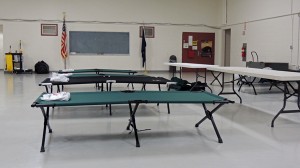Roadwork continues along K-Beach Road south of Kenai to try and alleviate some of the flooding in residential areas there. The high groundwater is not only making it difficult to navigate several roads, it’s also left people without water in their homes.
The Red Cross has a shelter set up at the Kenai Armory on South Forest. When I stopped by, they had just finished getting some cots and tables set up, and volunteers were still hanging signs. But no one had come seeking relief shortly before noon.

“They’ll have a place to sleep, take a shower. We’ll have meals prepared for them every day and meals for them as they need it. We’re looking at (housing) maybe a dozen, but we’re prepared to handle as many as we need to handle,” said Red Cross district manager Bill Morrow.
The shelter is being made available as more and more residents in the area are without water, as wells and septic systems are out of service for a good chunk of the neighborhood.
I spoke to a few people over the weekend who insisted their neighbors had it worse than they did. Their toilets were still flushing and they hadn’t resorted to paper plates and microwavable dinners just yet. But for other areas, water safety has already been a concern for weeks.
Jamie Bjorkman of the Alaska Department of Environmental Conservation told residents at a community meeting that well tests would be in order, but that until the water actually recedes, boiling or using bottled water would be the safest way to go.
“Once those flood waters are gone, you might want to go through a disinfection of your water system and test you system for total coliform bacteria. It indicates if there’s any harmful bacteria in your system,” she said.
The presence of coliform bacteria isn’t harmful in and of itself, but does indicate that there’s a pathway for more dangerous bacteria, like E. coli.
Ideally, the improvements made for water drainage and storage along K-Beach will help bring water levels down soon, but a hard winter freeze could be just around the corner which would undoubtedly complicate things. But Bjorkman says you can still test your septic system, even if it does freeze.
“A nitrate test will let you know if your septic system is affecting your drinking water. The reason we recommend the nitrate test at colder temperatures is because when everything freezes up, that bacteria can die if it gets cold enough, but you’ll still see nitrates.”
For residents choosing to stay at home, the Borough has provided clean-up kits and dry-chemical toilet units. Those are available at the Central Emergency Service Fire station on K-Beach.
Shaylon Cochran is a host and reporter at KDLL in Kenai. He’s reported on fishing, energy, agriculture and local politics since coming to Alaska in 2011. He has worked at KDLL/KBBI on the Kenai Peninsula, where he picked up lots of new hobbies, like smoking salmon, raising chickens, skiing and counting RV’s. He holds a bachelors degree in Journalism from Iowa State University.




